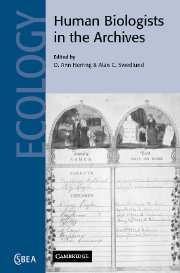 Human Biologists in the Archives
Human Biologists in the Archives Published online by Cambridge University Press: 12 August 2009
Introduction
Understanding the lives of women in medieval Britain (a period spanning roughly the twelfth through the sixteenth centuries) has a been a subject of interest and research for some time. Insights into numerous aspects of women's lives have been made through the use of documentary sources. For instance, early contributions by Abram (1916), Dale (1933), and Thrupp (1948), as well as more recent contributions by Power (1975), Charles and Duffin (1985), Hanawalt (1986), Goldberg (1991, 1992, 1995), Rosenthal (1990) and Jewell (1996) explore women's socioeconomic roles and contributions through the arclysis of many types of documentary evidence, including parish church records, poll tax returns, legal documents, and literary sources, to name a few. The interplay between women and law has also been evaluated for a considerable number of years (see Abram 1916; Sheehan 1963; Cannon 1999), as have medieval women's private and family roles (see Goody 1983; Goldberg 1991; Hanawalt 1986; Kowaleski 1988), women and medicine (see Greene 1989–90, 1994), and women and religion (Power 1922; Thompson 1991; Jewell 1996).
Using historical documents to understand the lives of medieval women, however, has well-recognized limitations. In England, for instance, church records of births, marriages, baptisms, and deaths were not made compulsory until 1538 (Palliser 1979). Prior to that, records were seldom kept, or were kept by particular families or wealthy parishes. Similarly, the use of tombstones did not become a popular means of marking graves and/or providing information about the deceased until the seventeenth century (Johnson 1912).
To save this book to your Kindle, first ensure [email protected] is added to your Approved Personal Document E-mail List under your Personal Document Settings on the Manage Your Content and Devices page of your Amazon account. Then enter the ‘name’ part of your Kindle email address below. Find out more about saving to your Kindle.
Note you can select to save to either the @free.kindle.com or @kindle.com variations. ‘@free.kindle.com’ emails are free but can only be saved to your device when it is connected to wi-fi. ‘@kindle.com’ emails can be delivered even when you are not connected to wi-fi, but note that service fees apply.
Find out more about the Kindle Personal Document Service.
To save content items to your account, please confirm that you agree to abide by our usage policies. If this is the first time you use this feature, you will be asked to authorise Cambridge Core to connect with your account. Find out more about saving content to Dropbox.
To save content items to your account, please confirm that you agree to abide by our usage policies. If this is the first time you use this feature, you will be asked to authorise Cambridge Core to connect with your account. Find out more about saving content to Google Drive.